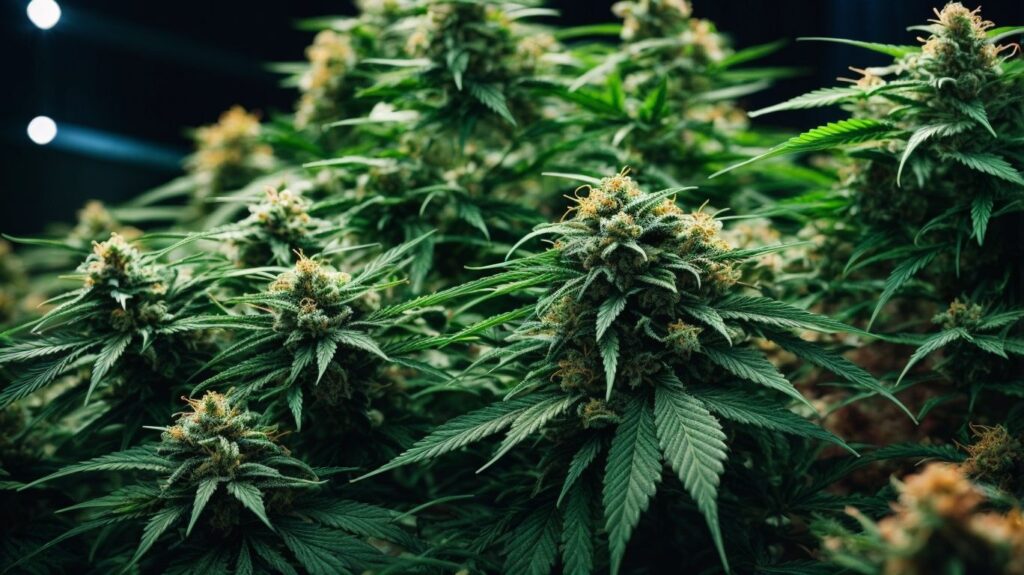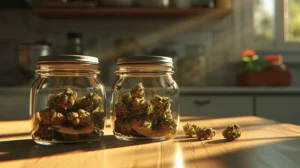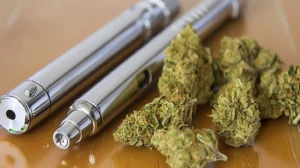Introduction Flowering Stage
Cannabis plants go through different stages of growth, and the flowering stage is a crucial phase for home cultivators. This is when the plants start developing buds that contain the psychoactive compounds such as THC and CBD.
In this article, we will discuss key tips and best practices for caring for cannabis plants during the flowering stage in home cultivation.
The flowering stage, also known as the blooming stage, is the third stage of a cannabis plant’s life cycle. This is when the plant transitions from the vegetative stage, where it focuses on growing leaves and stems, to the reproductive stage, where it produces flowers. The flowering stage is crucial because it determines the yield and potency of the buds. It is when the plants start producing the compounds that give them their medicinal and recreational properties. The flowering stage typically lasts for 8-9 weeks, but it can vary depending on the strain and growing conditions.
During this time, there are several key factors that home cultivators need to consider to ensure healthy and high-quality plants.
- Light Cycle: Cannabis plants need a specific light cycle during the flowering stage, with 12 hours of light and 12 hours of darkness. This cycle signals to the plants that it is time to start producing flowers.
- Temperature and Humidity: Maintaining the right temperature and humidity levels is crucial during the flowering stage. Temperatures between 68-77°F and humidity levels of 40-50% are ideal.
- Nutrient Levels: Cannabis plants require different levels of nutrients during the flowering stage, so it is essential to use fertilizers specifically designed for this phase.
- Pest and Disease Control: The flowering stage is a critical time to prevent and control pests and diseases as they can significantly damage the plants and affect the final product.
To ensure optimal growth and yields, here are some best practices to follow during the flowering stage:
- Pruning and Training: Pruning and training techniques can help improve the structure and yield of the plants during the flowering stage.
- Watering and Feeding: It is crucial to maintain a consistent watering and feeding schedule during the flowering stage, making sure not to over or underfeed the plants.
- Checking for Pests and Diseases: Regularly checking for pests and diseases, and using natural or organic methods of prevention and control can help maintain the health of the plants during this critical stage.
- Maintaining Optimal Light and Temperature: Continuously monitoring and adjusting the light and temperature levels is essential for healthy and potent buds.
Some common mistakes to avoid during the flowering stage include over or underfeeding, not controlling light exposure, and neglecting pest and disease prevention. These can significantly impact the final product.
Home cultivators can determine when the flowering stage is over by observing the appearance of the buds. The stigmas and trichomes will change color, and the plant will stop producing new white pistils.
When it is time to harvest, there are several steps to follow, including flushing the plants, trimming and drying the buds, and curing them for maximum potency and flavor.
By following these key tips and best practices, home cultivators can ensure a successful and rewarding cultivation experience during the flowering stage of their cannabis plants.
Key Takeaways:
Maintain a consistent light cycle, optimal temperature and humidity levels, and nutrient levels during the flowering stage to ensure healthy and productive cannabis plants. Regularly prune and train your plants, check for pests and diseases, and provide proper watering and feeding to promote strong growth and prevent common mistakes during the flowering stage. Properly flushing, trimming, and curing after the flowering stage is over is crucial for maximising the quality and potency of your harvested cannabis plants.
What is the Flowering Stage in Cannabis Plants?
The flowering stage in cannabis plants marks the period when the plants begin to produce buds. This phase is induced by the shift in light exposure, typically when the plants receive 12 hours of continuous darkness each day.
During this stage, it’s crucial to provide the right nutrients, maintain proper humidity levels, and ensure adequate airflow to prevent mold. Additionally, monitoring for pests and diseases is essential at this stage to safeguard the health of the plants.
Pro Tip: Consider using organic fertilizers high in phosphorus to support healthy bud development during the flowering stage.
Why is the Flowering Stage Important?
The flowering stage is crucial for cannabis plants as it marks the transition from vegetative growth to the production of buds. During this phase, the plant’s energy shifts towards bud development and resin production, influencing the yield and potency of the final product. Understanding why is the flowering stage important helps home cultivators to optimize care practices. It’s a time when nutrient requirements change, and environmental conditions, particularly light cycles, become pivotal in ensuring successful flowering. Factors such as pruning, support, and pest management also play key roles during this stage. Focusing on the flowering phase can significantly impact the overall quality and quantity of the harvest, making it a critical period in cannabis cultivation.
How Long Does the Flowering Stage Last?
The flowering stage typically lasts between 7 to 9 weeks, depending on the cannabis strain and environmental conditions. Regularly monitor the trichomes using a magnifying glass to determine the optimal harvest time. Ensure proper lighting cycles, maintaining a consistent 12-hour light and 12-hour dark cycle to promote flowering. Control the humidity and temperature levels, as fluctuations can affect the flowering duration. Provide adequate nutrients during this stage, adjusting the feeding regimen based on the plant’s specific needs.
In ancient China, cannabis was used for various medicinal purposes, and its fibres were employed for making textiles and paper. The rich history of cannabis cultivation dates back thousands of years, showcasing its significance in different cultures and civilisations.
What Are the Key Factors to Consider During the Flowering Stage?
As cannabis plants enter the flowering stage, there are several key factors that home cultivators must consider in order to ensure a successful harvest. In this section, we will discuss the essential elements that can greatly impact the growth and health of your plants during this critical stage. From the light cycle to nutrient levels, and even pest control, we will cover all the important aspects that should be carefully monitored and maintained in order to achieve optimal results.
1. Light Cycle
During the flowering stage, cannabis plants require a consistent light cycle to stimulate bud formation and growth.
Pro-tip: Maintain a 12-hour light cycle during the flowering stage to encourage robust bud development and maximize yield.
2. Temperature and Humidity
When considering the flowering stage of cannabis plants, temperature and humidity play crucial roles in ensuring optimal growth and bud development. Here are essential steps to manage temperature and humidity during the flowering stage:
- Monitor temperature: Maintain a consistent temperature range of 68-78°F (20-25°C) during the day and a slightly cooler range at night to mimic natural conditions.
- Regulate humidity: Keep humidity levels between 40-50% to prevent mold and mildew while ensuring the plants have enough moisture.
- Use dehumidifiers or humidifiers: Install these devices as needed to adjust humidity levels according to the specific requirements of the cannabis strain.
True story: A cannabis grower diligently maintained a controlled environment during the flowering stage, ensuring the temperature and humidity remained within the optimal range. This attention to detail resulted in a bountiful harvest of high-quality buds.
3. Nutrient Levels
Check the nutrient levels:
Monitor and maintain the proper balance of nutrients, including nitrogen, phosphorus, and potassium, to support healthy flowering and prevent deficiencies.
Adjust nutrient intake:
As the plant’s needs change during the flowering stage, adjust the nutrient levels accordingly to meet the increasing demands for flowering and bud development.
Use quality nutrients:
Ensure the use of high-quality, cannabis-specific nutrients to provide the essential elements required for robust flowering and optimal bud production.
4. Pest and Disease Control
Identify pests and diseases early by regularly inspecting plants during the flowering stage. Utilise organic pest control methods such as neem oil or insecticidal soap to address pest issues. Implement preventive measures like maintaining proper airflow and ventilation to discourage common cannabis diseases. Consider using beneficial insects such as ladybirds or predatory mites as a natural way to control pests. Practice good garden hygiene by removing any dead or decaying plant matter to prevent disease spread. When caring for cannabis plants during the flowering stage, it’s crucial to prioritise pest and disease control to ensure a successful harvest. By following these steps and staying proactive, you can safeguard your plants from potential threats and support their overall health and vitality.
What Are the Best Practices for Caring for Cannabis Plants During the Flowering Stage?
As a home grower, the flowering stage of your cannabis plants is critical to achieving a successful harvest. Proper care during this phase can result in healthy and potent buds. In this section, we will discuss the best practices for looking after your cannabis plants while they are in the flowering stage. From pruning and training to monitoring for pests and diseases, we will cover all the essential tips you need to know. So let’s get started and ensure your plants thrive during this crucial phase.
1. Pruning and Training
Pruning: Begin by removing any dead or yellowing leaves to redirect the plant’s energy towards bud production.
Training: Utilise techniques such as low-stress training (LST) or high-stress training (HST) to shape the plant, improve light exposure, and promote better bud development.
2. Watering and Feeding
Watering during flowering: Maintain a consistent watering schedule to prevent over or under-watering. Adjust watering frequency based on plant size, pot size, and environmental conditions. Use nutrient-rich water to support flowering growth.
Feeding requirements: Provide appropriate nutrients for the flowering stage, especially phosphorus and potassium. Utilize flowering-specific fertilizers to meet the plant’s nutritional needs. Adjust feeding based on plant development and nutrient uptake.
3. Checking for Pests and Diseases
Regularly inspect the plants for signs of pests and diseases, such as yellowing or spotted leaves, holes, webs, or visible pests. Utilise preventive measures like introducing beneficial insects or using organic pesticides to control pests and diseases.
Maintain a clean and well-ventilated grow space to minimise the risk of pest infestation and disease development. Implement proper watering and feeding practices to ensure plant health, as stressed plants are more susceptible to pests and diseases. Keep a close eye on the overall health and appearance of the plants to promptly address any pest or disease issues that may arise.
4. Maintaining Optimal Light and Temperature
During the flowering stage, it is crucial to maintain optimal light and temperature for the growth and development of cannabis plants. Ensure consistent light cycles, providing 12 hours of light and 12 hours of uninterrupted darkness to initiate and maintain the flowering phase. Monitor temperature levels, aiming for a range of 68-78°F (20-25.5°C) during the day and a slightly cooler temperature at night to mimic natural conditions. Regulate humidity between 40-50% to prevent mold and mildew while promoting healthy flowering. Consider using fans or ventilation to maintain adequate air circulation and prevent heat buildup around the plants.
What Are the Common Mistakes to Avoid During the Flowering Stage?
As any experienced cannabis grower knows, the flowering stage is a crucial time for the health and success of your plants. However, there are common mistakes that can be easily made during this stage, leading to subpar results or even the death of your plants. In this section, we will discuss the top mistakes to avoid during the flowering stage, including over or underfeeding your plants, not properly controlling light exposure, and neglecting to prevent pests and diseases. By learning from these common pitfalls, you can ensure a successful and bountiful harvest of your cannabis plants.
1. Over or Underfeeding
Monitor Plant Response:
Watch for signs of over or underfeeding, such as yellowing leaves or burnt tips.
Adjust Nutrient Levels:
Regularly check pH and EC levels in the soil or nutrient solution to ensure plants receive the correct balance of nutrients.
Follow Feeding Schedule:
Adhere to a feeding schedule based on the plant’s specific needs during the flowering stage, adjusting as necessary.
Observe Watering Patterns:
Use a consistent watering schedule and monitor the plant’s water intake to prevent over or underfeeding.
2. Not Controlling Light Exposure
Ensure Consistent Light Schedule:
Maintain a consistent 12-hour light and 12-hour dark cycle during the flowering stage to avoid light stress and interruptions to the plant’s natural processes.
Use Light-Blocking Techniques:
Employ light-blocking methods such as blackout curtains, shades, or lightproof tarps to prevent light leaks during the dark period, ensuring the plants receive uninterrupted darkness.
Monitor Light Sources:
Regularly check for any malfunctioning or stray light sources in the growing environment. Address any issues promptly to maintain the required light exposure.
As the cannabis industry continues to evolve, the cultivation of cannabis has become increasingly refined. With a rich history dating back thousands of years, cannabis has been utilized for medicinal, recreational, and industrial purposes across diverse cultures and regions.
3. Neglecting Pest and Disease Prevention
Implement regular inspections: Monitor the plants for any signs of pests or diseases, such as discolouration, spots, or unusual growth patterns.
Utilise preventive measures: Introduce beneficial insects or natural remedies to deter pests, and maintain a clean growing environment to prevent disease.
Follow a strict hygiene regimen: Clean and sterilise tools, containers, and the cultivation area to minimise the risk of pest infestations and disease spread.
Stay informed: Educate yourself about common pests and diseases that affect cannabis plants, and be proactive in preventing and addressing any issues.
Seek professional advice: If unsure about pest or disease management, consult with experienced growers or horticulturists for guidance.
How Do You Know When the Flowering Stage is Over?
Trichome Colour: Inspect the trichomes using a magnifying glass. When the trichomes turn from clear to cloudy, and then to amber, it indicates the end of the flowering phase.
Pistil Colour Change: Observe the pistils. When they change from white to dark red or brown, it signifies that the flowering stage is coming to an end.
Bud Swell: Monitor the buds for swelling. Towards the end of the flowering period, the buds will stop growing and swell, indicating the completion of the flowering stage.
Stamen Withering: Check for stamen withering. As the flowering stage concludes, the stamens within the buds will start to wither and die off.
Fragrance Change: Pay attention to the fragrance. When the sweet and floral aroma transitions into a stronger, more pungent smell, it often signifies the end of the flowering stage.
What is the Harvesting Process for Cannabis Plants?
As a home cultivator, it is crucial to understand the harvesting process for cannabis plants in order to achieve the best results. The final stage of cultivation involves several key steps that can greatly impact the quality and potency of your harvest. In this section, we will discuss the three main steps of the harvesting process: flushing, trimming and drying, and curing. By mastering these techniques, you can ensure that your cannabis plants reach their full potential during the flowering stage.
1. Flushing
When flushing cannabis plants, the process involves providing only water to the plants without any nutrients. This practice aims to remove excess nutrients and mineral buildup from the growing medium and the plants themselves.
Here’s a step-by-step guide:
- Prepare by stopping the use of nutrients and additives, and only water the plants with pH-balanced water.
- Continue flushing until the runoff water measures an acceptable level of total dissolved solids (TDS).
- Monitor the plant’s leaves for signs of nutrient deficiencies, and adjust the flushing process accordingly.
- Once the flushing process is complete, allow the plants to dry out before harvesting to enhance the quality of the final product.
2. Trimming and Drying
Trimming: After harvesting, carefully trim excess leaves around the buds. Use clean, sharp scissors to manicure the flowers, removing any remaining stems or leaves to enhance the appearance and quality of the final product.
Drying: Hang the trimmed buds upside down in a dark, well-ventilated area with a consistent temperature and humidity. Allow the buds to dry slowly for about 7-14 days until the outer layer feels crispy but the inner stem is still slightly bendable. Proper drying is crucial for preserving flavor, potency, and preventing mold growth.
Did you know? Properly dried and trimmed cannabis flowers have better flavor, aroma, and overall quality.
3. Curing
During the curing process in cannabis cultivation, follow these essential steps for optimal results:
- Harvest the plants when the trichomes are mostly cloudy with some amber hues.
- Trim excess leaves and hang the buds in a dark, well-ventilated area with 60% humidity for 5-15 days.
- After drying, place the buds in airtight containers, such as glass jars, to start the curing process.
- Burp the containers daily for the first two weeks to release excess moisture and prevent mold growth.
- Continue curing for 4-8 weeks, opening the jars less frequently as time progresses.
- Monitor the moisture content and maintain a relative humidity of 58-62% for optimal curing.
Properly cured cannabis will have improved flavor, smoothness, and potency, enhancing the overall experience.
Frequently Asked Questions
1. What are the key tips for caring for cannabis plants during the flowering stage in home cultivation?
Some key tips include maintaining ideal environmental conditions, using specialized filtration systems for air and water, keeping an eye on pH levels, and providing the right nutrients for optimal growth.
2. How long does the flowering stage typically last in cannabis plants?
The flowering stage usually lasts for about 8 weeks, but this can vary depending on the strain and growing conditions. It is important to closely monitor the plants during this period to determine the ideal harvest time.
3. How can I ensure proper light penetration during the flowering stage?
Using intense lighting, such as H.I.D grow bulbs, and monitoring the light intensity with a P.A.R rating can help ensure sufficient light penetration for healthy flower development.
4. What is the importance of air filtration during the flowering stage?
Air filtration is crucial for preventing bacteria and mold growth, providing filtered air for the plants, and maintaining appropriate carbon dioxide levels for optimal growth.
5. Can I use regular seeds for home cultivation during the flowering stage?
Yes, regular seeds can be used, but it is important to watch for intersex characteristics and remove any male or hermaphrodite plants to prevent pollination. Using feminized seeds can increase the chances of producing female plants for bud production.
6. What are the top tips for beginner growers during the flowering stage?
Some top tips include closely monitoring pH levels, using a feeding chart for proper nutrient balance, providing a controlled temperature with a fan controller, and checking for undissolved salts in the water source. It is also important to give the plants adequate space for their flowering stretch and to maintain a consistent lighting schedule of 12 hours of light followed by 12 hours of darkness.
Elevate Your Cannabis Cultivation Journey! Join our exclusive newsletter community and gain access to a wealth of knowledge on cannabis care, cultivation, and more. By subscribing, you’ll receive expert tips, insider secrets, and the latest trends, all delivered directly to your inbox. Don’t miss out on the opportunity to boost your home cultivation skills and achieve impressive results. Subscribe now and embark on a path to becoming a cannabis cultivation expert!






